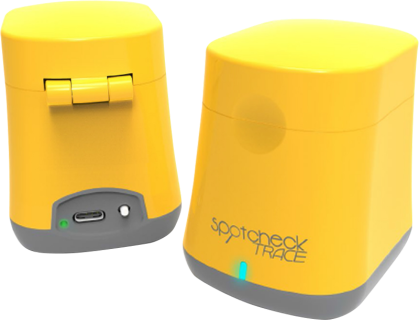Spotcheck Trace
Broad hazardous drug spectrum monitoring at a reasonable cost.


Using well known spectrophotometer assay techniques Spotcheck Trace reagents isolate and identify a common chemical entity found in eighty-five NIOSH listed drugs. The presence of this chemical entity in a Spotcheck Trace sample will trigger a color change which is captured via the Spotcheck Trace portable spectrometer, transmitted to and reported via your smart device app or PC.
Using a swab stick provided in the Spotcheck Trace kit, a target surface of approximately 30cm x 30cm (12 inch x 12 inch) is swabbed. The collect sample swab is placed in the Spotcheck Trace extraction solution and swirled for approximately 20 seconds. Three millilitres of this solution is then transferred to a cuvette. The cuvette is placed in the Spotcheck Trace spectrometer, a baseline reading is taken, an amount of Spotcheck Trace reagent is then added to the cuvette solution. Your Spotcheck Trace smart device application begins a three-minute countdown. When completed the results are sent to your smart device and reported via the Spotcheck Trace application.
Yes.
No. Spotcheck Trace will detect a drug substance is present but will not tell you exactly what drug it is.
At less than $50 per test and considerably less expensive than alternative HD tests, routine monitoring can be conducted using VeriWipes®. In cases of post-spill cleanup confirmation or where routine monitoring indicates a reoccurring problem, then Spotcheck Trace is used to confirm the presence of a hazardous drug.
Yes. While experience tells us that our bio-safety hoods are, in most cases, our cleanest area in the facility, calculators, pumps, etc are not. It is prudent to run an occasional spot check to confirm it is clean and Spotcheck Trace is perfect for that situation.
There is a small list of non-hazardous entities which may result in a positive reading. The amino acids alanine, arginine, glycine, histidine, isoleucine, leucine, L-aspartic and L-glutamic acids, proline, serine, threonine, tryptophan, and valine; found in the amino acid solutions used for total parenteral nutrition, may result in a low-level (< 0.1ppm) reading. Additionally, certain antibiotics; aztreonam, cefepime, and ceftazidime may result in a low-level (< 0.1ppm) reading. Premedication drugs commonly used in oncology (acetaminophen, atropine, meperidine, dexamethasone, diphenhydramine, famotidine, granisetron, hydromorphone, ibuprofen, magnesium sulfate, methylprednisolone, morphine sulfate, ondansetron, palonosetron, and, ranitidine) are non-reactive with the Spotcheck Trace assay.
No. When IPA is allowed to dry prior to testing a target surface it will not impact your Spotcheck Trace assay. If liquid IPA is introduced to a Spotcheck Trace sample it may cause turbidity (micro-precipitation) within the sample solution. Spotcheck Trace technology accounts for the potential for a dirty sample and will negate any effect on the assay result.
No. Spotcheck Trace only measures reacted sample within the cuvette. As the cuvette is single-use only, each sample is “fresh” and will not be impacted by the presence of HD contaminate in, or around, the meter.
No. Spotcheck Trace technology is designed to identify contaminate within the sample and account for it in it’s reading. Therefore, you can test an uncleaned, dusty sample from any surface within your facility and conduct an assay with confidence.